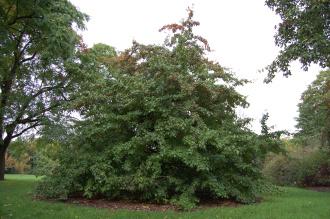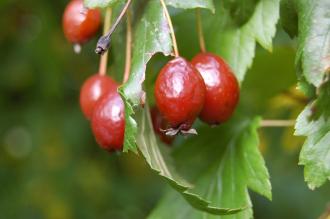
Malus florentina (21/10/2013, Kew Gardens, London)
Position: Full sun to partial shade
Flowering period: Late spring to early summer
Soil: Moist, well drained
Eventual Height: 8m
Eventual Spread: 6m
Hardiness: 6a, 6b, 7a, 7b, 8a, 8b, 9a, 9b, 10a, 10b
Family: Rosaceae
Malus florentina is a deciduous tree with a rounded habit. Its dark green leaves are ovate with deeply serrate/ lobed margins, up to 12cm long and 8cm broad. Its leaves turn orange/ red in autumn before they fall. Its white flowers are up to 18mm across and appear in clusters of up to 7. Its red fruit are pomes, up to 15mm long, 8m wide and appear in autumn.

Malus florentina Fruit (21/10/2013, Kew Gardens, London)
Malus florentina, commonly known as Florentine Crabapple, Italian Crabapple or Hawthorn Leaf Crabapple, is native to the Balkans and Italy.
The etymological root of the binomial name Malus is the ancient Latin name for the apple tree. Florentina is derived from the Latin meaning ‘from Florence’.
The landscape architect may find Malus florentina useful as a small ornamental tree with attractive spring flowers, autumn leaves and autumn fruit which are attractive to birds.
Ecologically, Malus florentina flowers are attractive to pollinating insects. Its fruit are attractive to some birds and mammals.

Malus florentina Leaf (21/10/2013, Kew Gardens, London)
Malus florentina prefers moist, fertile, well-drained soils. It tolerates most pH of soil.
Malus florentina requires little maintenance.

